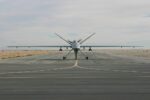The Armored Group (TAG), a U.S.-based manufacturer of tactical and armored vehicles, has introduced a new family of modular armored platforms designed to enhance troop mobility while integrating advanced counter-unmanned aerial systems (C-UAS) capabilities. The launch reflects growing demand for multi-role land systems capable of addressing both conventional and asymmetric threats in complex operational environments.
Modular Design Philosophy for Multi-Mission Flexibility
The new vehicle lineup from TAG is built around a modular chassis concept that allows rapid reconfiguration to suit mission-specific requirements. According to company statements and available imagery from the launch event at the 2025 AUSA Expo in Washington D.C., the platforms are based on a monocoque V-hull design offering scalable protection levels up to STANAG 4569 Level 4. The base variant can be adapted for roles including:
- Troop transport (up to 10 dismounts)
- Command and control (C2) node
- Counter-drone and electronic warfare platform
- Medical evacuation (MEDEVAC)
The modularity extends beyond mission kits. Armor packages can be swapped or upgraded in-theater using bolt-on composite panels or reactive armor modules. Powertrain options include diesel-electric hybrid configurations aimed at reducing acoustic and thermal signatures during silent watch operations.
Integrated Counter-UAS Suite Targets Emerging Drone Threats
A key differentiator of TAG’s new platform series is the integration of counter-unmanned aerial system (C-UAS) technologies as part of the baseline offering. While specifics vary by configuration, TAG has partnered with several COTS providers to embed layered drone defense capabilities directly into the vehicle architecture.
The C-UAS suite includes:
- 360° radar-based detection system with AI-assisted target classification
- Electro-optical/infrared (EO/IR) sensors for visual confirmation and tracking
- RF jamming modules capable of disrupting commercial drone control links within a several-kilometer radius
- Optional hard-kill interceptors such as directed-energy weapons or kinetic launchers (under evaluation)
This integration reflects lessons learned from recent conflicts where small UAVs have been used extensively for ISR and loitering munition attacks against soft-skinned vehicles and dismounted troops. By embedding C-UAS directly into troop carriers rather than relying solely on standalone systems or fixed installations, TAG aims to provide maneuver units with organic drone defense on the move.
Tactical Mobility Meets Survivability in Asymmetric Environments
The vehicle’s design prioritizes survivability without sacrificing off-road mobility. Standard features across variants include run-flat tires, central tire inflation systems (CTIS), blast-attenuating seats, and spall liners. Ground clearance exceeds 400 mm depending on configuration, supporting high mobility across rough terrain.
The monocoque V-hull offers underbody blast protection against mines and IEDs equivalent to NATO STANAG Level 3a/3b or higher when equipped with full armor kits. Crew compartments are overpressurized for CBRN protection in contested environments.
TAG also emphasizes ease of maintenance via commercial off-the-shelf components where possible—particularly in powertrain and suspension subsystems—to simplify logistics support in austere theaters.
Target Markets: Special Forces, Peacekeeping Units, Border Security Forces
TAG is positioning the platform family for both domestic U.S. users—such as National Guard units—and international customers operating in high-threat regions. Given its modularity and relatively low logistical footprint compared to heavier MRAP-class vehicles like Oshkosh M-ATV or Nexter Aravis, it may appeal particularly to:
- Special operations forces requiring configurable mission packages
- UN peacekeeping contingents needing scalable protection levels without heavy infrastructure support
- Southeast Asian or African militaries seeking cost-effective counter-drone solutions integrated into mobile assets
Program Status and Future Development Roadmap
The new platform series is currently undergoing internal validation trials at TAG’s Arizona proving grounds. According to company representatives at AUSA 2025, limited production units will be available for customer evaluation by Q1 2026. Full-rate production could begin by late 2026 pending orders.
TAG is also exploring potential licensing agreements with foreign partners for localized assembly under offset arrangements—a common requirement in Middle Eastern and Southeast Asian procurement programs.
Operational Implications: Toward Organic Mobile Drone Defense
The introduction of this platform reflects a broader trend toward integrating C-UAS capabilities directly into tactical formations rather than relying on separate specialist units or static defenses. As loitering munitions proliferate among both state actors and non-state groups—including use by irregular forces in Ukraine, Syria, Libya—the need for mobile organic protection becomes urgent.
If successful in trials and adopted widely, TAG’s approach could influence future design baselines across NATO-standard light armored vehicle programs—especially those intended for expeditionary roles where threat environments evolve rapidly.








